





The Australian Yowie Research Centre Est...1976 by Rex Gilroy for the sole purpose of Scientific Study of the Australian Hairy - man |
 |
 |
  |
 |
 |
The Australian Yowie Research Centre Est...1976 by Rex Gilroy in for the sole purpose of Scientific Study of the Australian Hairy - man |
||||
Aboriginal Traditions - Myths and Legend The Australian Yowie Research Centre Original Site. Click here The most common 'hairy man' was undoubtedly that which existed throughout the eastern Australia mountain ranges (although I have found they also occurred elsewhere in Australia in ancient times). They were known by many names depending upon the numerous dialects spoken by the Aboriginal people, but all translated to the same meaning-'hairy man'. The Yowies were described as standing, in the case of males, 2m to 2.6m tall, being hairy, muscular creatures; whereas the females were smaller, at around 1.5m tall, with less hair, of lighter build and with long pendulous breasts. The head of these creatures differed from Aborigines, in that they were long and narrow in shape. The general Appearance of these primitive beings recalls Homo erectus (Java Man), as will be demonstrated anon. |
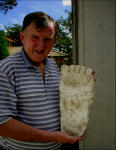 Casts |
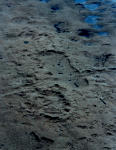 Tracks |
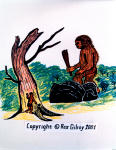 Drawings |
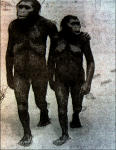 Homo erectus |
The Australian Yowie
|
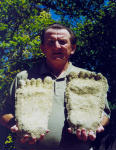 Video 2 |
 Video 3 |
 Video 5 |
Rex Gilroy Interviews 2004
|
Aboriginal Traditions - Myths and Legend cont... According to the Aborigines, the sounds emitted by these 'hairy people' varies from grunts to howling. They wandered the remoter forest regions of the eastern mountains ranges, often in small family groups, sometimes in pairs or singularly, sleeping in caves, rock overhangs or in open forest depending upon weather conditions. They were known to make fire, manufacture crude stone and wooden tools and killing animals for food, as well as feeding upon nuts, roots and berries. They were to be territorial by nature, regarding any place in which they were temporarily in occupation of as if their own, chasing out any rival groups of their own kind, and also any Aborigines who chanced to wander into their territory. |
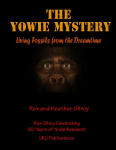 1700's |
 1800's |
 Modern Reports |
 Descriptions |
The Australian Yowie Research Centre
|
 Fossil Footprints |
 Aboriginal Art |
 Myths & Legends |
 Negrito Pygmy Folk |
 Relict Hominds |
The Australian Yowie Research Centre
|
Comparison's With Other Relict Hominid's For many people the Yowie's description automatically evokes comparisons with the Himalayan Yeti and 'Bigfoot' of north America. Or lesser known Almastis (hairy man of the forest) of Russia; the Chaing Mi (wild man) of China; the Mie tie (apeman) of Malaysia, and the Kiboornee (hairy jungle devil) of New Guinea. Whether all these creatures are related is another matter. Footprints left by the Yeti reveal apelike, rather than human features, while some researchers tend to link the Almastis with 'Bigfoot' who together with the Yeti, is argued to be a surviving form of the Pleistocene man-like ape, Gigantopithecus. The Chaing Mi and Mie Tie and Kiboornee, by their physical descriptions may be linked to the Yowie, as probable surviving Homo erectines, and this also appears to be the identity of the Moeau,of New Zealand. American professor Grover T Krantz, (Grover has since died R.I.P) anthropologist of Washington State University, has from exhaustive studies and comparisons of what he considered to be authentic footprint plaster casts of 'Bigfoot', concluded that the creature may be a living representative of Gigantopithecus. |
 |
 |
 |
 |
 |
The Australian Yowie Research Centre Files In the following years Following World War One, there were still a few old men and woman living in the hornsby districts, who repeated tales of 'hairy man' encounters in the area generations before, such as one account of two men having shot dead a 'hairy man' almost twice the height of an average human, that approached then from out of nearby scrub, about the year 1800; and that a 'Yahoo' was shot dead by soldiers in the same area about 1822 |
 |
 |
 |
 |
 |
The Australian Yowie Research Centre Files About 1895, one of the last of the Aborigines of the Blue Mountains, who were an offshoot of the old Mulgoa and Burragorang tribes, declared there was a Yowie living in the neighbourhood of the 'Devils hole' near Narrow neck, Katoomba. He even volunteered to take a European aquaintance to the exact place and there leave him to interview the creature at leisure, but the offer was declined. |
Comparison's With Other Relict Hominid's cont... American professor Grover T Krantz, (Grover has since died R.I.P) anthropologist of Washington State University, has from exhaustive studies and comparisons of what he considered to be authentic footprint plaster casts of 'Bigfoot', concluded that the creature may be a living representative of Gigantopithecus. Gigantopithecus is known only from its fossilised jaws and teeth, and thought to have existed in Asia from about five million years ago. The great size of its fossil jaw suggests Gigantopithecus reached a height of around 3 metres. Despite widespread scientific opinion that Gigantopithecus would have walked on its knuckles, like a gorilla, and not on its two feet, Professor Krantz has made a convincing argument based on the spread of the lower jaw, that Gigantopithecus was actually an erect biped. "If you change a gorilla to a vertical posture like a human, and make the neck come straight down, one thing you have to do is spread the back of its lower jaw room for the neck. And as can be shown, the lower jaw of Gigantopithecus spread much more widely than the jaw of a gorilla." "Gigantopithecus was so much like the Sasquatch that I would assume Gigantopithecus is alivetoday", says Krantz. |
 |
 |
 |
 |
 |
The Australian Yowie Research Centre Gigantopithecus, the 'South China Giant", orignally identified from six large fossil teeth found in a Hong Kong Chinese chemist's shop by Dutch Paleontologist Ralph von Koenigswald in 1934, does appear to fit the description of the Sasquatch. |
 |
 |
 |
 |
 |
The Australian Yowie Research Centre Fossil jaws and teeth of Gigantopithecus unearthed in China since von Loenigswald's initial discovery show these monster-apes subsisted on seeds, berries and other herbivorous food, although there must have been meat-eating forms, as suggested by the Australian Aboriginal traditions, concerning the habits of the giant hominds (of Gigantopithecus appearance) |
New Zealand Evidence There is a mystery lurking in the wild, untamed mountains and forests of New Zealand. It is a mystery dismissed as a myth by anthropologists, but one which has persisted since the arrival of the first Maori colonists from Polynesia centuries ago. The mystery concerns the existence of races of primitive, hairy, giant-size and smaller hominids, said to have survived in these wilds since ice-age times.Perhaps the ‘mystery’ has not so much to do with their existence, but how these hominids were able to reach New Zealand in the first place. The logical explanation is that they arrived here via a land-bridge that formerly connected New Zealand to Melanesia-Australia. Could such a ‘bridge’ have existed? |
 |
 |
 |
 |
 |
The Australian Yowie Research Centre
|
 |
 |
 |
 |
 |
The Australian Yowie Research Centre
|
The Australian Yowie Research Centre Est...1976 by Rex Gilroy for the sole purpose of Scientific Study of the Australian Hairy - man |
 |
 |
  |
 |
 |
The Australian Yowie Research Centre Est...1976 by Rex Gilroy in for the sole purpose of Scientific Study of the Australian Hairy - man |
||||
|